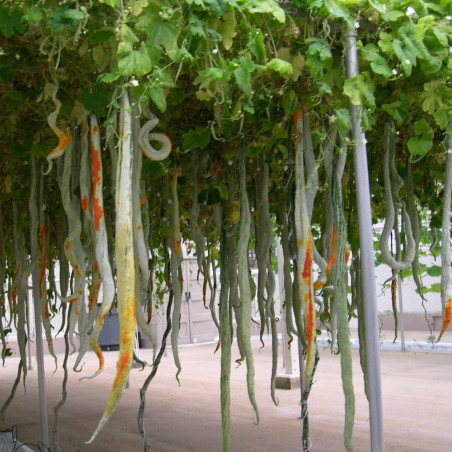
SNAKE GOURD Seeds (Trichosanthes cucumerina)
SNAKE GOURD Seeds (Trichosanthes cucumerina)
Price for Package of 3 seeds.
Snake gourds are long and curved vegetables that fall into two different categories. There are the extremely long varieties that are grown for ornamental purposes and have hard skin
SNAKE GOURD Seeds (Trichosanthes cucumerina)
Price for Package of 3 seeds.
Snake gourds are long and curved vegetables that fall into two different categories. There are the extremely long varieties that are grown for ornamental purposes and have hard skin and there are those grown for eating and medicinal purposes.
These Snake gourds have a waxy green skin and are often speckled or striped with a lighter shade of green. The fruit is eaten when young. Longer varieties are best harvested when they are between 16 and 18 inches long. Smaller varieties are best harvested at 6 to 8 inches in length.
When the gourd is young, the seeds are fairly nonexistent and the pulp around the seed mass is firm. The taste of a Snake gourd is similar to that of a cucumber. As a Snake gourd gets older, the rind gets hard and turns red. The taste becomes bitter and the insides gelatinous. The seeds are very hard and look similar to jagged-edged watermelon seeds.
Seasons/Availability
Snake gourds are available during the late summer and fall months.
Current Facts
Some of the longest gourds in the world are known as Snake gourd or ‘Serpent’ gourd. There are several varieties of Snake gourd that are cultivated and grown in India and other areas of the sub-tropics. These cucumber relatives can grow up to five or six feet long and when dried, can be made into a didgeridoo, an Australian Aboriginal wind instrument. Farmers tie stones to the ends of the fruit to weigh it down while it grows, to ensure straighter gourds.
Applications
Snake gourd can be prepared and used like zucchini; sautéed and served as a side dish or added to dishes with other sautéed vegetables. Snake gourds can also be stuffed or sliced and grilled. In Asian dishes, Snake gourd is made into chutneys and pickled. When the gourd is mature, the seed mass within is scraped out and used like tomato paste in various Indian dishes.
Ethnic/Cultural Info
In Ayurveda, the ancient medical system of India, the Snake gourd serves multiple purposes. Ingesting the fruit, leaves and flowers of the Snake gourd plant aided in digestive disorders, diabetes, skin diseases and general malaise.
Geography/History
Snake gourds are native to southeastern Asia, Australia and the islands of the Western Pacific. Originally domesticated in India, the serpent-like gourd can be found growing in Africa and other tropical and sub-tropical areas around the world. Botanically known as Trichosanthes cucumerina, Snake gourd seeds traveled from China to Europe via traders in the early 18th century, and were believed to have been planted at Monticello by Thomas Jefferson in 1820.
WIKIPEDIA:
Trichosanthes cucumerina is a tropical or subtropical vine, its variety T. cucumerina var. anguina raised for its strikingly long fruit, in Asia eaten immature as a vegetable much like the summer squash, and in Africa, the reddish pulp of its mature fruit is used as an economical substitute of tomato.[2] Common names of the cultivated variety include snake gourd[note 1],[4] serpent gourd,[4] chichinda,[4] and padwal[4] (not to be confused with Trichosanthes dioica, the parwal, another gourd edible when immature).
Trichosanthes cucumerina is found in the wild across much of South and Southeast Asia, including India, Bangladesh, Nepal, Pakistan, Sri Lanka, Indonesia, Malaysia, Myanmar (Burma), and southern China (Guangxi and Yunnan).[5] It is also regarded as native in northern Australia.[6][7] and naturalized in Florida,[8] parts of Africa and on various islands in the Indian and Pacific Oceans.[9]
Formerly, the cultivated form was considered a distinct species, T. anguina, but it is now generally regarded as conspecific with the wild populations, as they freely interbreed:
Trichosanthes cucumerina var. anguina (L.) Haines – cultivated variant
Trichosanthes cucumerina var. cucumerina – wild variant
Trichosanthes cucumerina is a monoecious annual vine climbing by means of tendrils. Leaves are palmately lobed, up to 25 cm long. Flowers are unisexual, white, opening at night, with long branching hairs on the margins of the petals. These hairs are curled up in the daytime when the flower is closed, but unfurl at night to form a delicate lacy display (see photos in gallery below). Fruits can be up to 200 cm long, deep red at maturity, hanging below the vine.
The related Japanese snake gourd (Trichosanthes pilosa, sometimes called T. ovigera or T. cucumeroides), very similar in vegetative morphology, but the fruit of T. pilosa is round to egg-shaped, only about 7 cm long.
Uses
The common name "snake gourd" refers to the narrow, twisted, elongated fruit. The soft-skinned immature fruit can reach up to 150 cm (59 in) in length. Its soft, bland, somewhat mucilaginous flesh is similar to that of the luffa and the calabash. It is popular in the cuisines of South Asia and Southeast Asia and is now grown in some home gardens in Africa. With some cultivars, the immature fruit has an unpleasant odor and a slightly bitter taste, both of which disappear in cooking. The fruit becomes too bitter to eat as it reaches maturity, but it does contain a reddish pulp that is used in Africa as a substitute for tomatoes.
The shoots, tendrils, and leaves are also eaten as greens.
| HEIRLOOM ? | Yes |
|---|---|
| Organic Seeds ? | Organic Seeds |
| Edible ? | Edible |
| Pretreatment of sowing ? | Soak in water before sowing 12-24 h |
| Sowing depth ? | Sowing depth 5 mm |
| Medicinal Plant ? | Medicinal Plant: Yes |
| Handpicked seeds ? | Handpicked seeds |


Your review appreciation cannot be sent
Report comment
Report sent
Your report cannot be sent
Write your review
Review sent
Your review cannot be sent
🌍 Global Delivery from the EU
We ship worldwide from the European Union via registered mail with delivery confirmation.
📦 Shipment Tracking
To find your tracking number, log in to your account and go to Order History > Details.
Global tracking: 17Track
For tracking numbers like RGxxxxxxHR: Posta.hr tracking
🕒 Note: Tracking information becomes available up to 24 hours after your order is shipped.
⚠️ Important Notices
Cash on delivery is not available.
Regularly check your spam/junk email folder for notifications.
All inquiries must be submitted via our contact form on the website.
Messages sent via regular email may not be received.
📱 Required at Checkout
Always include your mobile phone number with international dialing code.
Example for Hungary: +36 20 123 4567
🚚 Delivery Policy
Registered shipments require a signature from the recipient.
We do NOT deliver:
to P.O. boxes
to neighbors
if you are not home to receive the package
📬 If a P.O. box address is provided and the package is lost or undeliverable, it will not be refunded.
↩️ Return & Reshipping
If your package is returned to us:
You will be charged €2 for return shipping
You are responsible for reshipping costs as well
⏱ Delays & Tracking Issues
If tracking shows the package is still with the sender, it means it is in transit.
Contact your local post office with the tracking number for updates.
We are not a postal service and cannot track your package for you.
We are not responsible for shipping delays.
🔍 We can only start an investigation into a lost shipment 30 days after the dispatch date.
✈️ Delivery Options
| Type of Delivery | Processing Time | Insured | Possible Delays | Notes |
|---|---|---|---|---|
| Standard | 7–10 business days | ❌ | 7–14 days | Basic shipping option |
| Priority | 1–7 business days | ❌ | 3–10 days | Faster processing, not faster shipping |
| Insured | 1–7 business days | ✅ | 3–10 days | Refund if the package is lost (up to €150) |
🕒 Estimated Delivery Time:
Within the EU: 3–20 days
Worldwide: 5–30 days
Example delivery times to the USA: 27, 22, 19, 17, 13 days
💳 Payment Options
💶 Bank Transfer (SEPA / IBAN / SWIFT-BIC)
Always include your order reference (e.g., SGS-19811702) in the payment description.
If we cannot match your payment to your order, it may cause delays or cancellation.
Orders are automatically canceled if payment is not received within 7 days.
🅿️ PayPal
We accept EUR currency only via PayPal.
Please change your currency to Euro during checkout.
💳 Card Payment
Visit: Exotic Seeds Store
We accept: Visa, MasterCard, American Express, CB, Diners Club, Discover, China UnionPay, JCB, etc.
💡 Buyers are responsible for all transaction fees. Please send us your transaction details so we can process your order promptly.
📅 Other Information
Orders are not processed or shipped on Saturdays or Sundays.
Always check the Important Notices on our website before placing an order (e.g., holiday schedules, special conditions).
📫 For any questions, please use only the contact form on our website.
Emails sent outside of this form will not be received.
Related Products





















